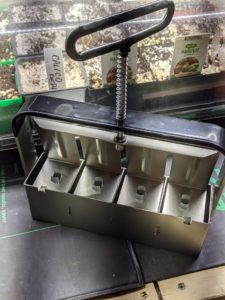I was always an ornamental plant grower and landscaper for all the time I’ve tended gardens in Texas. Somehow I’ve always felt that growing vegetables in the harsh climate required too much effort and resources for a family of two trying to hold down full time jobs and paying the bills. Any vegetable that I’ve dropped into the ground usually involved some kind of plant that could endure the grueling Texas heat. This usually meant peppers of all varieties, a potato or two, and maybe something from the onion/garlic family. I know tomatoes are said to do well in our summers, but I don’t like eating tomatoes. Of course, when I can manage to irrigate them properly, I’m always growing herbs…I tend to have a lot of success growing warm season herbs such as rosemary, sage, oregano, thyme and basils.
With the state of the world in 2020, I’ve had the opportunity to work from home and sharpen my growing skills. I’m happy to report that mostly everything I’ve grown from seed this year has survived with the attention given them. I have lost very little in terms of new and existing outdoor/landscape plants as well.
With achievement under my belt, I’ve set out to grow some cole crops (vegetables I’ve always wanted to grow and eat) starting the fall/winter season. I anticipate starting in the cooler climate will guarantee me some vegetable harvests by next year, especially growing broccoli, brussel sprouts, cauliflower, and Asian cabbages.
I’ve done my research by this list of resources to help plan with vegetable growing in my zone for this season.
- Vegetable Variety Selector at Texas A&M Agrilife Extension: aggie-horticulture.tamu.edu/publications/veg_variety/select.php
- Recommended Planting Dates for North Texas download: agrilife.org/urbantarranthorticulture/files/2020/06/Recommended_Planting_Dates_for_North_Texas.pdf
- Gardener’s Supply Company Garden Design Planner (for spacing out plants): gardeners.com/on/demandware.store/Sites-Gardeners-Site/default/KGP-Design
- North Texas Vegetable Gardeners Blog: northtexasvegetablegardeners.com
- Neil Sperry’s Gardens: neilsperry.com
Seed/Plant Local Resources:
- Painted Flower Farm: paintedflowerfarm.com
- North Haven Gardens: nhg.com
- Shades of Green Frisco: shadesofgreeninc.com
- Covington Nursery and Landscape Co: covingtonnursery.com
- Calloway’s: calloways.com
- Strong’s Nursery and Garden Center: strongsnurseryandgardencenter.com
- Cristina’s Garden Center: cristinasgc.com
Online seed/plant companies:
- Baker Creek Heirloom Seeds: rareseeds.com
- Colonial Creek Farm: colonialcreekfarm.com
- Annie’s Annuals: anniesannuals.com
- Swallowtail Garden Seed: swallowtailgardenseeds.com
- Kitazawa Seed kitazawaseed.com
- Stoke Seeds stokeseeds.com
- Burpee burpee.com
- Johnny’s Selected Seeds johnnyseeds.com
Blogs and channels I follow:
- Denton County Master Gardener Association: dcmga.com
- The Dallas Garden: thedallasgarden.com
- Epic Gardening: epicgardening.com
- Central Texas Gardener: centraltexasgardener.org
- Sherrie the Okra Lady: linktr.ee/TheOkraLady
- Jill’s Garden in North Texas: instagram.com/seedsanddreams
- Colorful World Acreage: instagram.com/colorfulworldacreage/
- The North Texas Gardener: linktr.ee/Thenorthtexasgardener
- Bag of Bees: instagram.com/bagofbees
- The Nakid Gardeners: linktr.ee/thenakidgardeners
- Urban Gardening TX: instagram.com/urbangardeningtx/

I recently learned of a work perk offered for free through my job. I recently signed up for online courses with Start Organic. I’ve been attending webinars hosted by the Start Organic team to learn about urban organic vegetable gardening. If your workplace/company offers this educational course to its employees, it’s well worth participating in if you’re interested in learning to start organic gardening.



















